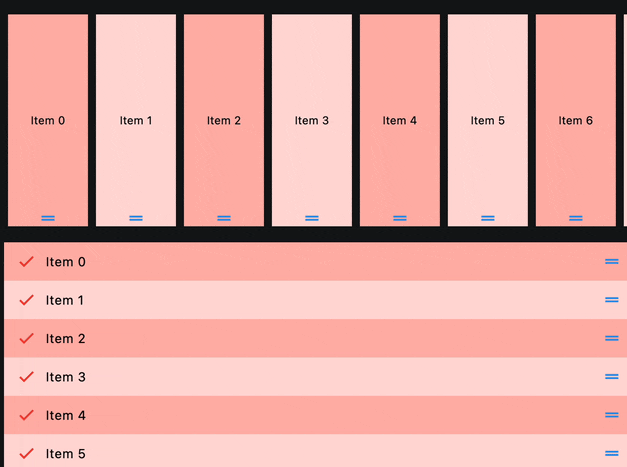ReorderableListView
A control that allows the user to reorder its children by dragging a handle.
Examples
Basic example
loading...

Properties
anchor
The relative position of the zero scroll offset.
Defaults to 0.0.
auto_scroller_velocity_scalar
The velocity scalar per pixel over scroll. It represents how the velocity scale with the over scroll distance. The auto-scroll velocity = (distance of overscroll) * velocity scalar.
build_controls_on_demand
Whether the controls should be built lazily/on-demand, i.e. only when they are about to become visible.
This is particularly useful when dealing with a large number of controls.
Defaults to True.
cache_extent
The viewport has an area before and after the visible area to cache items that are about to become visible when the user scrolls.
Items that fall in this cache area are laid out even though they are not (yet) visible on screen. The cache_extent describes how many pixels the cache area extends before the leading edge and after the trailing edge of the viewport.
The total extent, which the viewport will try to cover with children, is cache_extent before the leading edge + extent of the main axis + cache_extent after the trailing edge.
The cache area is also used to implement implicit accessibility scrolling on iOS: When the accessibility focus moves from an item in the visible viewport to an invisible item in the cache area, the framework will bring that item into view with an (implicit) scroll action.
controls
The controls to be reordered.
clip_behavior
The content will be clipped (or not) according to this option.
Value is of type ClipBehavior and defaults to ClipBehavior.HARD_EDGE.
first_item_prototype
True if the dimensions of the first item should be used as a "prototype" for all other items, i.e. their height or
width will be the same as the first item.
Defaults to False.
footer
A non-reorderable footer item to show after the controls.
Value is of type Control.
header
A non-reorderable header item to show before the controls.
Value is of type Control.
horizontal
Whether the controls should be laid out horizontally.
Defaults to False.
item_extent
If non-null, forces the children to have the given extent in the scroll direction.
Specifying an item_extent is more efficient than letting the children determine their own extent because the scrolling machinery can make use of the foreknowledge of the children's extent to save work, for example when the scroll position changes drastically.
padding
The amount of space by which to inset the controls.
Value is of type Padding.
Events
on_reorder
Fires when a child control has been dragged to a new location in the list and the application should update the order of the items.
on_reorder_end
Fires when the dragged item is dropped.
on_reorder_start
Fires when an item drag has started.
Event handler argument is of type OnReorderEvent.